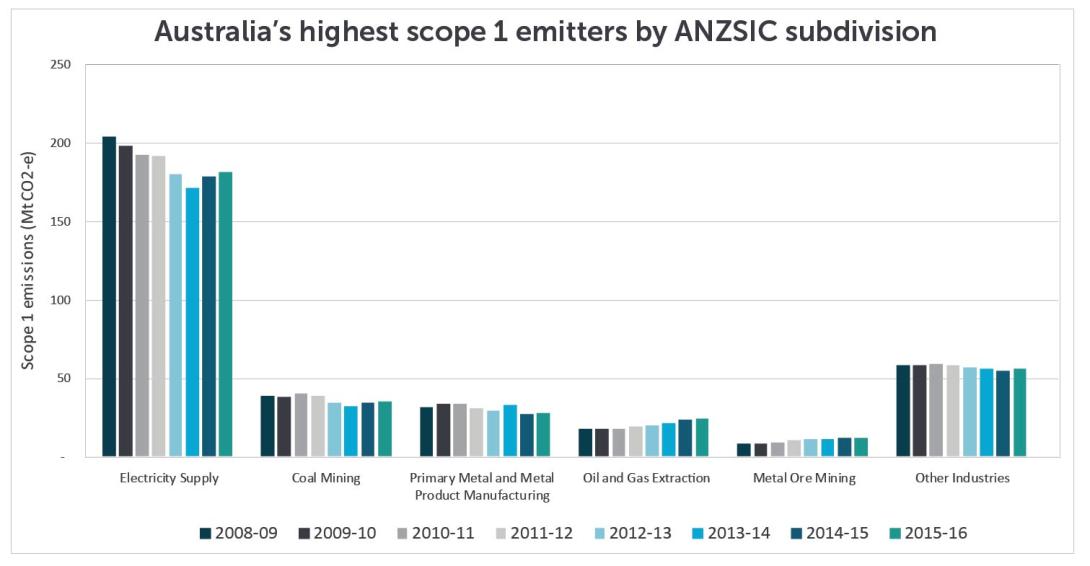For this publication, greenhouse and energy data reported under the National Greenhouse and Energy Reporting scheme has been grouped according to the Australian and New Zealand Standard Industrial Classification (ANZSIC) subdivision, which is a system that was developed for use in both countries for the production and analysis of industry statistics.
It is a legislative requirement that, except when expressly permitted, individual reporters cannot be identified when National Greenhouse and Energy Reporting scheme data is published. Where an ANZSIC subdivision has too few facilities represented, the aggregated data is not included in the table below. Instead this data is collectively included in a separate line item.
Australia’s emissions according to industry (ANZSIC subdivisions)
Each individual reporter assigns the ANZSIC code for each facility reported based on its predominant activity. ANZSIC codes are broken up into divisions, subdivisions, classes and subclasses. Information has been presented at the ANZSIC subdivision level.
The five ANZSIC subdivisions with the most emissions have stayed the same since the 2012-13 National Greenhouse and Energy Reporting scheme reporting year. The top five subdivisions are electricity supply, coal mining, primary metal and metal product manufacturing, oil and gas extraction and metal ore mining. Electricity supply is the subdivision that reports the most scope 1 emissions.
The data in this publication has undergone a quality assurance process and adjustments to reported ANZSIC subdivisions have been made where appropriate.
As ANZSIC codes are self-reported, the Clean Energy Regulator cannot guarantee the accuracy of the codes chosen by reporters although efforts have been made to identify any significant errors.
Where a Vertically Integrated Production Process (VIPP) has been reported, emissions from this report have been allocated to the appropriate industry.
Some data has been withheld in some categories to ensure anonymity of reporters which is required under the legislation.
This chart and dataset reflect changes in the global warming potential factors for carbon dioxide equivalent emissions that came into effect in the 2015-16 reporting year.

Manufacturing subdivision | 2008-09 | 2009-10 | 2010-11 | 2011-12 | 2012-13 | 2013-14 | 2014-15 |
|---|---|---|---|---|---|---|---|
Electricity Supply | 203,083,134 | 197,297,688 | 191,955,178 | 190,087,726 | 178,959,159 | 170,414,273 | 178,509,620 |
Coal Mining | 33,414,449 | 32,921,457 | 34,607,064 | 33,419,154 | 29,908,562 | 28,569,698 | 29,947,728 |
Primary Metal and Metal Product Manufacturing | 30,943,538 | 32,964,278 | 33,479,595 | 30,143,484 | 29,021,460 | 29,719,050 | 26,499,893 |
Oil and Gas Extraction | 16,865,334 | 17,408,685 | 17,372,573 | 18,056,585 | 19,531,508 | 20,933,920 | 22,570,137 |
Metal Ore Mining | 8,140,183 | 8,224,419 | 8,857,919 | 9,828,238 | 10,553,885 | 10,885,176 | 11,313,750 |
Other industries | 56,923,555 | 57,272,688 | 58,025,714 | 57,041,402 | 55,621,947 | 54,734,069 | 53,436,702 |
Australia’s scope 1 emissions by ANZSIC subdivision for NGER
For detailed information on the dataset for Australia’s scope 1 emissions by ANZSIC subdivision for the entire reporting history of National Greenhouse and Energy Reporting download the excel spreadsheet. For a subset of this data see the below table.
Australias scope 1 emissions by ANZSIC subdivision for NGER Reporters
|